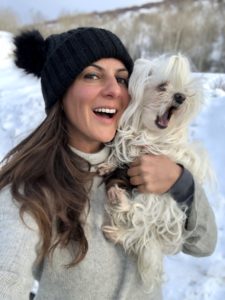I started backcountry skiing only this winter. The ski season ended abruptly when the Coronavirus closed the resorts, but the gorgeous snow-covered mountains were still there. Backcountry skiing aka alpine touring aka skinning up requires a different set of equipment than that used when riding lifts. Here I’ll give you a brief introduction to backcountry skiing.
Backcountry skiing involves hiking up the hill before skiing down. Ski touring bindings allow you to have your heel free when climbing. Also “skins” are required. One side of skins has one directional carpet-like fabric and the other side sticks to the base of your skis. The fabric allows you to slide forward while climbing but keeps you from slipping backward. You remove the skins when you’re ready to ski downhill. A 2-hour backcountry outing might only include one run or two runs because you “earn your turns”. After climbing for an hour, skiing down might take only 5 minutes.
The boots, bindings and skis are slightly different from resort skis. Touring skis are lighter, thinner, wider, and longer which is especially helpful for “floatation” when skiing in powder snow. The bindings have two settings: (1) the heel of your foot is free while climbing (2) both your toe and heel are attached to the ski while skiing downhill.
While climbing:
The heel binding is not attached as in this photo below. The skins are on, the boot buckles are loose, and my jacket and hat are in my backpack. All zippers are open because I’m sweating from the exertion of climbing.
While skiing downhill:
The skins are in my backpack. Both toe and heel bindings are attached, and my boots are buckled tight.
Here are the items I purchased for my inbound backcountry adventures
- Skis – Blizzard Zero G 105 in 172 cm
- Lange XT Free 110W low volume ski boots in 23.5
- Salomon S/Lab Shift MNC Ski Bindings
- Black Diamond Ultralite Mix STS Climbing Skins in 110mm Dark Grey 110
Regular fixed-length ski poles are OK, but adjustable, light-weight poles have advantages.
The backpack is helpful for carrying your skins, water, snacks and extra layers. When in the backcountry where avalanches are possible, a probe, shovel, and beacon are essential.
Inbound versus backcountry
Inbound means that the skiers climb up and ski down within the borders of the resort. It’s a good place to learn because avalanche risk is low, there are facilities, and runs are monitored by the ski patrol and are usually groomed.
Backcountry means an unmonitored area where there are no facilities, ski patrol or ski lifts. Backcountry skiers operate at their own risk, and I’m not one of those…yet. Maybe next winter. I have done cat skiing and heliskiing. You can read about my adventures. LINK COMING
Backcountry skiing has been my savior and centering activity during the quarantine. I kept a good social distance and rarely saw 2 to 4 other other people all day.
To me, being in the arms of mother nature is so empowering. Looking out on a mountain panorama makes me feel insignificant yet connected to the “big picture” at the same time. The minor troubles of my life seem to vanish. It’s easier to feel powerful and in control on the groomed runs of a resort. In the wild backcountry, I feel more humble and small.
Would you like to join me in a ski retreat adventure? We offer custom trips in Chile and Park City, I’d be happy to discuss your wants and plan your upcoming memories together. Contact me for your custom ski/snowboard trips here.
